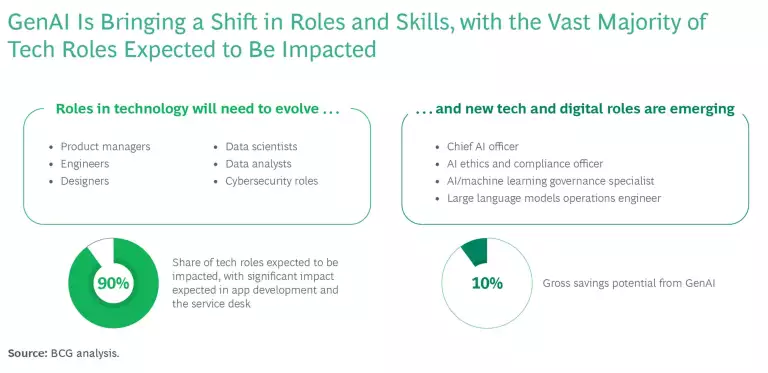BCG estimates that 90% of tech jobs will be directly impacted by
generative AI
(GenAI). In an already complex market for tech talent, these shifts will create new challenges for technology leaders. How will they face the dual mandate of building GenAI capabilities within their own department while leading the charge for implementing GenAI across the entire enterprise?
The So What
To succeed, tech leaders need to rethink how they can mobilize talent in response to GenAI.
We estimate that AI will reduce costs in the tech function by approximately 10%—or free up capacity that tech leaders can reallocate to other areas.
There are four developments driving this.
For the vast majority of tech jobs, roles and skills will change as employees increasingly incorporate GenAI into their processes and workflows. For example, data scientists will need to work with greater volumes of unstructured data to train large language models (LLMs) and generate insights.

GenAI will make many tasks within tech functions more efficient. For example, it will increasingly take on tasks like generating code for app development and handling transactional processes in tech support, requiring fewer resources and time dedicated to these tasks.
Both AI and GenAI will create new roles as well. One example is the role of a chief AI officer—a senior person specifically tasked with overseeing all AI projects and use cases, including predictive AI and GenAI. Similarly, most organizations will need prompt engineers to develop and refine the prompts given to GenAI solutions. LLM operations engineers will need to work to simplify and automate prompt processes and fine-tune models.
Skills will evolve with GenAI. This evolution can be seen in individual roles, such as a data scientist upskilling in prompt engineering and fine-tuning AI models. Over time, GenAI skills will become table stakes across tech and digital roles.
Dive Deeper
In addition to understanding specific skills, roles, and capabilities, technology leaders need to determine the right organizational structure for the tech function, so that GenAI capabilities and expertise are positioned where they can be most effective.
Start by centralizing GenAI expertise. Initially, a company can create a center of excellence that sits within the tech function and reports to the technology leader. This approach enables an organization to accelerate the rollout of GenAI while establishing guardrails for the responsible, ethical use of the technology. Cross-functional ambassadors can foster collaboration across business units, working with the technology leader to implement responsible AI and train broader business teams on GenAI usage.
Decentralize over time. As capabilities grow, the company can shift to a decentralized model, with GenAI squads embedded into business units and support functions to implement GenAI use cases. In this stage, the tech function’s responsibility shifts to monitoring and governance, evolving the common infrastructure and security standards, and continuing to refine the guardrails for GenAI.
What Else
Technology leaders need to rethink their talent strategy to account for the added capacity from GenAI. They have two principal options.
Reduce headcount. As GenAI automates processes and workflows, some companies may opt to eliminate some roles and apply the cash savings to other areas.
- Many tech functions currently focus on hiring entry-level engineering talent through university partnerships and internships. But GenAI-enabled companies will need fewer junior engineers in the short term. As a result, tech leaders will need to adjust their recruiting to focus more on senior engineers until GenAI upskilling through college becomes table stakes for entry-level talent.
- Career paths and performance management will also need to change for the smaller number of high-caliber employees who have the skills required to design and implement GenAI use cases. These people will be in high demand by most organizations, so tech leaders need to take the steps necessary to retain them.
- The employee value proposition will also remain essential to attract and retain top senior talent with GenAI experience.
Overall, this scenario would lead to a leaner tech function.
Redeploy talent. Other companies may opt to redeploy the talent that GenAI frees up, applying those employees to other needs.
- Some of these roles (such as tech support) have traditionally been based in offshore locations. These employees could be shifted to high-value and more strategic work by rethinking the function of those locations. For example, an offshore tech-support site could evolve to an innovation center focused on a specific product or service.
- Shifting all employees—offshore or in the corporate center—to higher-value work requires upskilling and reskilling initiatives.
- Capacity planning in short and long term will be essential to effectively redeploy talent across high-priority use cases and manage talent gaps.
- Ultimately, tech leaders need to clearly prioritize GenAI use cases to identify specific capabilities needed and identify where current technology talent can be redeployed.
This scenario would help the tech function create more value for the company.
Now What
The talent market is already competitive, and GenAI will exacerbate the competition for top tech talent in key areas. To succeed, technology leaders should focus on the following priorities:
Conduct a rapid assessment of the organization to understand the current baseline of capabilities and where GenAI applications can have the biggest impact.
Establish a center of excellence for GenAI within the tech function.
Prioritize a small number of use cases—both within the tech function and across a small
number of business units—to begin building institutional expertise and get people engaged.
Build and refine governance over time, even as you begin adopting GenAI.













